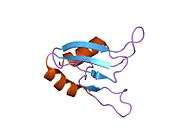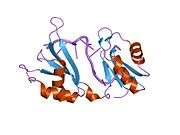HuD (protein)
HuD otherwise known as ELAV-like protein 4 is a protein that in humans is encoded by the ELAVL4 gene.[5][6]
The HuD/ELAVL4 protein is an RNA-binding protein.[7] HuD contains three RRM protein domains, enabling RNA binding.[8]
HuD is expressed only in neurons and it binds to AU-rich element-containing mRNAs. As a result of this interaction the half-life of the transcript is increased. HuD is important in neurons during brain development and plasticity.[9][10]
Interactions
HuD (protein) has been shown to interact with NXF1.[11]
gollark: Which is as far as I know more an issue of low voltages than DC itself, but DC means you can't change the voltage very easily.
gollark: There is the problem that low-voltage DC loses power more quickly over longer distances.
gollark: Yes, you're right, let's just replace our lightbulbs with idealized magic visible light emitters.
gollark: If they didn't need that (I think the only practical way to achieve this would just be to stick one larger and more efficient converter somewhere) the bulbs would be individually cheaper and probably more efficient too, as well as safer.
gollark: You know something mildly interesting and relevant? LEDs run off lowish-voltage DC. The mains, as connected to most conventional lightbulb fittings (designed for incandescent/flourescent) provides high-voltage AC. This means that every LED lightbulb needs inefficient and probably somewhat expensive power supply circuitry.
References
- GRCh38: Ensembl release 89: ENSG00000162374 - Ensembl, May 2017
- GRCm38: Ensembl release 89: ENSMUSG00000028546 - Ensembl, May 2017
- "Human PubMed Reference:". National Center for Biotechnology Information, U.S. National Library of Medicine.
- "Mouse PubMed Reference:". National Center for Biotechnology Information, U.S. National Library of Medicine.
- Muresu R, Baldini A, Gress T, Posner JB, Furneaux HM, Siniscalco M (Dec 1993). "Mapping of the gene coding for a paraneoplastic encephalomyelitis antigen (HuD) to human chromosome site 1p34". Cytogenet Cell Genet. 65 (3): 177–8. doi:10.1159/000133626. PMID 8222755.
- "Entrez Gene: ELAVL4 ELAV (embryonic lethal, abnormal vision, Drosophila)-like 4 (Hu antigen D)".
- Szabo A, Dalmau J, Manley G, et al. (1991). "HuD, a paraneoplastic encephalomyelitis antigen, contains RNA-binding domains and is homologous to Elav and Sex-lethal". Cell. 67 (2): 325–33. doi:10.1016/0092-8674(91)90184-Z. PMID 1655278.
- Lukong, Kiven E.; Chang, Kai-wei; Khandjian, Edouard W.; Richard, Stéphane (2008-08-01). "RNA-binding proteins in human genetic disease". Trends in Genetics. 24 (8): 416–425. doi:10.1016/j.tig.2008.05.004. ISSN 0168-9525. PMID 18597886.
- Nora Perrone-Bizzozero; Federico Bolognani (2002). "Role of HuD and other RNA-binding proteins in neural development and plasticity". J Neurosci Res. 68 (2): 121–126. doi:10.1002/jnr.10175. PMID 11948657.
- Federico Bolognani; Nora Perrone-Bizzozero (2008). "RNA-protein interactions and control of mRNA stability in neurons". J Neurosci Res. 86 (3): 481–489. doi:10.1002/jnr.21473. PMID 17853436.
- Saito, Kuniaki; Fujiwara Toshinobu; Katahira Jun; Inoue Kunio; Sakamoto Hiroshi (Aug 2004). "TAP/NXF1, the primary mRNA export receptor, specifically interacts with a neuronal RNA-binding protein HuD". Biochem. Biophys. Res. Commun. United States. 321 (2): 291–7. doi:10.1016/j.bbrc.2004.06.140. ISSN 0006-291X. PMID 15358174.
Further reading
- Dalmau J, Furneaux HM, Cordon-Cardo C, Posner JB (1992). "The expression of the Hu (paraneoplastic encephalomyelitis/sensory neuronopathy) antigen in human normal and tumor tissues". Am. J. Pathol. 141 (4): 881–6. PMC 1886624. PMID 1415481.CS1 maint: multiple names: authors list (link)
- Szabo A, Dalmau J, Manley G, et al. (1991). "HuD, a paraneoplastic encephalomyelitis antigen, contains RNA-binding domains and is homologous to Elav and Sex-lethal". Cell. 67 (2): 325–33. doi:10.1016/0092-8674(91)90184-Z. PMID 1655278.
- Graus F, Ferrer I (1990). "Analysis of a neuronal antigen (Hu) expression in the developing rat brain detected by autoantibodies from patients with paraneoplastic encephalomyelitis". Neurosci. Lett. 112 (1): 14–8. doi:10.1016/0304-3940(90)90314-Y. PMID 2166930.
- Sekido Y, Bader SA, Carbone DP, et al. (1994). "Molecular analysis of the HuD gene encoding a paraneoplastic encephalomyelitis antigen in human lung cancer cell lines". Cancer Res. 54 (18): 4988–92. PMID 8069866.
- Torà M, Graus F, de Bolòs C, Real FX (1997). "Cell surface expression of paraneoplastic encephalomyelitis/sensory neuronopathy-associated Hu antigens in small-cell lung cancers and neuroblastomas". Neurology. 48 (3): 735–41. doi:10.1212/wnl.48.3.735. PMID 9065557.
- Lazarova DL, Spengler BA, Biedler JL, Ross RA (1999). "HuD, a neuronal-specific RNA-binding protein, is a putative regulator of N-myc pre-mRNA processing/stability in malignant human neuroblasts". Oncogene. 18 (17): 2703–10. doi:10.1038/sj.onc.1202621. PMID 10348344.
- Park S, Myszka DG, Yu M, et al. (2000). "HuD RNA recognition motifs play distinct roles in the formation of a stable complex with AU-rich RNA". Mol. Cell. Biol. 20 (13): 4765–72. doi:10.1128/MCB.20.13.4765-4772.2000. PMC 85909. PMID 10848602.
- Wang X, Tanaka Hall TM (2001). "Structural basis for recognition of AU-rich element RNA by the HuD protein". Nat. Struct. Biol. 8 (2): 141–5. doi:10.1038/84131. PMID 11175903.
- Beckel-Mitchener AC, Miera A, Keller R, Perrone-Bizzozero NI (2002). "Poly(A) tail length-dependent stabilization of GAP-43 mRNA by the RNA-binding protein HuD". J. Biol. Chem. 277 (31): 27996–8002. doi:10.1074/jbc.M201982200. PMID 12034726.
- Behrends U, Jandl T, Golbeck A, et al. (2002). "Novel products of the HUD, HUC, NNP-1 and alpha-internexin genes identified by autologous antibody screening of a pediatric neuroblastoma library". Int. J. Cancer. 100 (6): 669–77. doi:10.1002/ijc.10550. PMID 12209604.
- Aronov S, Aranda G, Behar L, Ginzburg I (2003). "Visualization of translated tau protein in the axons of neuronal P19 cells and characterization of tau RNP granules". J. Cell Sci. 115 (Pt 19): 3817–27. doi:10.1242/jcs.00058. PMID 12235292.
- Angenstein F, Evans AM, Settlage RE, et al. (2002). "A receptor for activated C kinase is part of messenger ribonucleoprotein complexes associated with polyA-mRNAs in neurons". J. Neurosci. 22 (20): 8827–37. doi:10.1523/JNEUROSCI.22-20-08827.2002. PMID 12388589.
- Deschenes-Furry J, Belanger G, Perrone-Bizzozero N, Jasmin BJ (2003). "Post-transcriptional regulation of acetylcholinesterase mRNAs in nerve growth factor-treated PC12 cells by the RNA-binding protein HuD". J. Biol. Chem. 278 (8): 5710–7. doi:10.1074/jbc.M209383200. PMID 12468554.
- Strausberg RL, Feingold EA, Grouse LH, et al. (2003). "Generation and initial analysis of more than 15,000 full-length human and mouse cDNA sequences". Proc. Natl. Acad. Sci. U.S.A. 99 (26): 16899–903. Bibcode:2002PNAS...9916899M. doi:10.1073/pnas.242603899. PMC 139241. PMID 12477932.
- Plonquet A, Garcia-Pons F, Fernandez E, et al. (2004). "Peptides derived from the onconeural HuD protein can elicit cytotoxic responses in HHD mouse and human". J. Neuroimmunol. 142 (1–2): 93–100. doi:10.1016/S0165-5728(03)00269-8. PMID 14512168.
- Saito K, Fujiwara T, Katahira J, et al. (2004). "TAP/NXF1, the primary mRNA export receptor, specifically interacts with a neuronal RNA-binding protein HuD". Biochem. Biophys. Res. Commun. 321 (2): 291–7. doi:10.1016/j.bbrc.2004.06.140. PMID 15358174.
- Rousseau A, Benyahia B, Dalmau J, et al. (2005). "T cell response to Hu-D peptides in patients with anti-Hu syndrome". J. Neurooncol. 71 (3): 231–6. doi:10.1007/s11060-004-1723-1. PMC 2586925. PMID 15735910.
- Noureddine MA, Qin XJ, Oliveira SA, et al. (2005). "Association between the neuron-specific RNA-binding protein ELAVL4 and Parkinson disease". Hum. Genet. 117 (1): 27–33. doi:10.1007/s00439-005-1259-2. PMID 15827745.
- Rual JF, Venkatesan K, Hao T, et al. (2005). "Towards a proteome-scale map of the human protein-protein interaction network". Nature. 437 (7062): 1173–8. Bibcode:2005Natur.437.1173R. doi:10.1038/nature04209. PMID 16189514.
This article is issued from Wikipedia. The text is licensed under Creative Commons - Attribution - Sharealike. Additional terms may apply for the media files.









